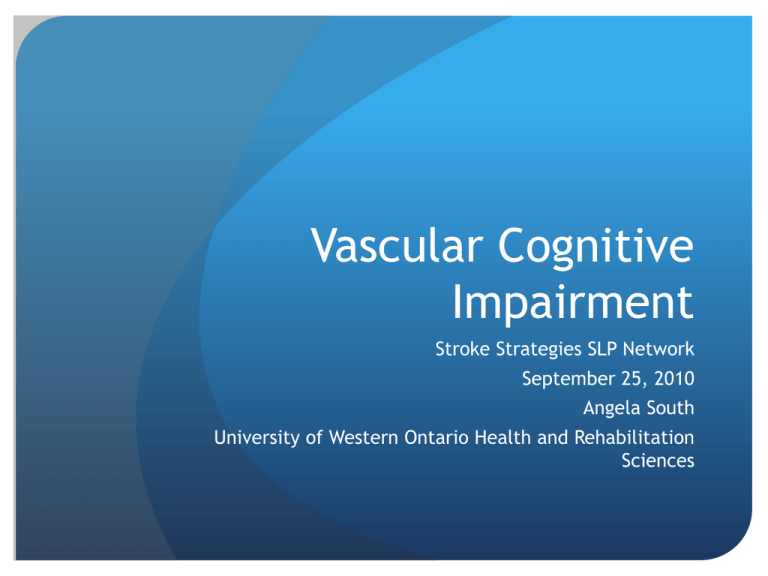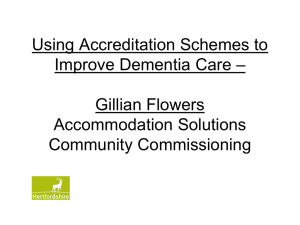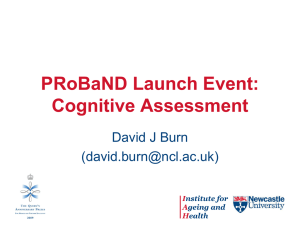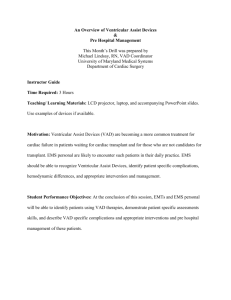Cognition
advertisement

Vascular Cognitive Impairment Stroke Strategies SLP Network September 25, 2010 Angela South University of Western Ontario Health and Rehabilitation Sciences Disclosures Funding from Parkinson’s Society Canada CIHR, NSERC, Parkinson’s Society Canada and Alzheimer’s Society funded laboratories A man does not consist of memory alone. He has feeling, will, sensibilities, moral being --- matters of which neuropsychology cannot speak. And it is here, beyond the realm of an impersonal psychology, that you may find ways to touch him, and change him. Luria AR From a personal letter to Oliver Sacks quoted in his 1985 book The Man Who Mistook His Wife For a Hat London: Picador (p.32) Objectives Review the incidence and prevalence of dementia and vascular cognitive impairment Define vascular cognitive impairment and subtypes Define the risk factors for vascular cognitive impairment Discuss the impact of post-stroke cognitive impairment Review a historical perspective of VCI Discuss deficits specific to VaD and VCI Discuss potential assessment and treatment implications Historical Perspective – the pendulum swings In 1896 Kraepelin made the first distinction between VaD and the tangles of AD on pathology examination Vascular etiologies were thought to account for almost all dementia cases until the 1960’s and 70’s when focus shifted to AD pathologies Now the pendulum is shifting back to a vascular etiology with a focus on the overlap between AD-VCI • Dr. Hachinski first to describe Multi-infarct dementia (MID) and this was the center of the VaD discussion • Today – the term VaD is used in a much wider context than Hachinski, et al first described • MID has lost popularity because VaD can be caused by single infarcts. It is used more now as a subtype of VaD • A struggle for a taxonomy • Vascular cognitive impairment (VCI) vs Vascular dementia (VaD) vs. VCI-ND • Vascular cognitive disorder (VCD) including VaD and VCI (equating more to MCI of vascular etiology) (Gustavo, et al, 2004) Dementia Epidemiology – Worldwide* 35.6 million estimated 2010 (24.2M 2001; 4.6M new cases/yr) 46% Asia 30% Europe 12% North America Doubling ~ every 20 years 65.7M 2030; 115.4M 2050 Majority (57.7%) live in low and middle income countries 40% increase Europe over next 20 yrs 63% ↑ North America 77% ↑ southern Latin America; 134-146% rest of Latin America 89% ↑ Asia Pacific; 117% East Asia; 107% South Asia 125% ↑ North Africa and Middle East $315 B (2005 US $) costs for dementia care/yr worldwide * Alzheimer’s Disease International World Report, 2009 www.alz.co.uk/worldreport ; Ferri et al., 2005; Wimo et al., 2003 Dementia Epidemiology – Selected Countries USA (http://www.alz.org/national/documents/report_alzfactsfigures2009.pdf) 5.3 million ~ 500,000 < 65 yrs old (~ 200 K with AD) ~ $148 billion/yr for care UK (http://www.alzheimers.org.uk/downloads/Dementia_UK_Full_Report.pdf) 700,000 ~15,000 < 65 yrs old > £17 billion/yr for care 2/3 live in community Epidemiology and Demographics: Prevalence – Canada* ~ 500,000 (8% of 65+) (% distribution: community = institutions) 103,000 new cases/yr (70,000 DAT) (CSHA, 2000) +71,000 < 65 yrs old ~1.5-2 ♀: 1 ♂ 2.4% 65-74 yrs 34.5% 85+ yrs > 592,000 cases by 2021 (65 yrs + = 23-24% total pop) # cases will triple by 2031 (close to 1 million) (http://www.alzheimer.ca/english/disease/stats-intro.htm; Alz. Soc. Canada, 2010; CSHA I Working Group, 1994, CMAJ) Ontario and London Profiles (courtesy Dr. M. Borrie) Ontario (12,803,900 ) 2007 160,624 2016 207,188 London (348,237) (LHIN 2) 2007 13,912 2016 16,805 Projected growth of 11.7%/yr yielding +300 new cases/yr Prevalence of VaD Conservatively 1-4% of individuals 65 and older have VaD Prevalence doubling every 5-10 years In pathologically confirmed cases of dementia VaD is second only to AD and many cases have a mixed VaD/AD pathology (Kirshner, 2010) Likely underestimated for a variety of reasons Clear definition of the disorder Overlap with CVD Overlap with AD Prevalence of VaD Conservatively 1-4% of individuals 65 and older have VaD Prevalence doubling every 5-10 years In pathologically confirmed cases of dementia VaD is second only to AD and many cases have a mixed VaD/AD pathology (Kirshner, 2010) Likely underestimated for a variety of reasons Clear definition of the disorder Overlap with CVD Overlap with AD Types of Dementia: Selected Examples DAT/AD Familial-DAT Early onset-DAT Down’s syndrome-DAT Mixed (DAT + VaD) Vascular dementia (VaD) Vascular cognitive impairment (VCI) Dementia with Lewy bodies (DLB) FTLD (FLD [Fv plus sub-variants] + PNFA [Fv] + semantic dementia [Tv]) PPA FTLD Pick’s Dementia with motor neurone diseases and movement disorders ALS, Parkinson’s, MS, HC, etc. Dementia lacking distinctive histology (DLDH) Binswanger disease Pick Complex Progressive supranuclear palsy (PSP) and corticobasal degeneration (CBD) AIDS dementia complex (ADC) Creutzfeldt-Jakob disease (CJD) Normal pressure hydrocephalus (NPH) Syphilis Wernicke-Korsakoff syndrome Dementia Syndrome of acquired, progressive, persistent decline in 3 of 5 spheres of mental activity (Cummings, Benson, & LoVerme, 1980) 1. Memory 2. Language and communication 3. Personality 4. Visuospatial skills 5. Cognition (e.g., reasoning, abstraction, judgement, etc.) Mild Cognitive Impairment (MCI) (Ritchie & Touchon, 2000) Not considered normal for age and education level Defined clinically or neuropsychologically Evolved from earlier concepts of cognitive decline in aging without dementia: Benign senescent forgetfulness (Kral, 1962) Age-associated memory impairment (Crook et al., 1986) Age-associated cognitive decline (Levy et al., 1994) Mild cognitive decline (ICD-10, 1993) Cognitively impaired not demented (CSHA, 1994) Cognitively impaired not demented yet (CINDY) (CSHA, 1994) Mild Cognitive Impairment (MCI) (Petersen et al. 1999; Mendez & Cummings, 2003) 1. Memory complaint, preferably corroborated by informant 2. Objective memory impairment corrected for age and education (i.e., scores 1.5 SDs or more below Mean for normals) 3. Largely intact general cognitive function 4. Essentially preserved activities of daily living (ADL) 5. Not demented 6. No specific medical, neurological or psychiatric causes for memory difficulty Dementia: DSM IV-TR (2000) Multiple cognitive deficits of Cognitive deficits: 1. Cause significant gradual onset and continual impairment in social or decline including both: A. B. Memory impairment One (or more) of the following: 1. Language problems 2. Movement programming problems (apraxia) 3. Perceptions stripped of meaning (agnosia) 4. Disturbance in executive functioning (e.g., planning, organizing, sequencing ideas, etc.) occupational functioning 2. Represent significant decline from previous functioning Not due to other CNS conditions, systemic conditions known to cause dementia, substance abuse induced dementia, delirium, another primary psychiatric disorder Defining VaD (an enigma) DSM – IV – TR (2000) • Memory impairment • Impairment in one other cognitive domain (language or Visuospatial) • Presence of cerebrovascular disease (focal clinical signs or imaging) • Cognitive deficits must be related to CVD and severe enough to impair daily functional activities. Defining VCI/VaD Heterogenous Onset of cognitve impairment dementia should have a temporal orientation to a CVD event Severity depends on strategic location of infarcts and volume of injury (tissue damage) Left carona radiata (Pohlasvaara, et al) Thalamus (RMDAS study) Post-stroke cognitive impairment (Vakhnina, et al 2009) Incidence of impaired cognitive function post stroke in the elderly = 40-60% during first 6 months post TIA’s, strokes with minimal impairments, minor strokes Severity reaches dementia criteria in 5-7% of cases in the first 6 months post and in 20-25% of cases within 5 years of the stroke (non-severe ischemic strokes) Stroke can lead to recurrence or clinical manifestation of underlying dementia or other neurodegenerative processes The development of additional cerebrovascular disease in the presence of at least 2 lacunar infarcts significantly probability of AD manifesting (Vakhnina, et al 2009) Mild cognitive impairment (MCI or VaMCI is a major determinant of post-stroke dementia: 8% conversion per year from VaMCI to VaD (Sachdev, et al 2009) Those with greater executive function and language impairment post stroke tended to progress to VaD. Behavioural findings were more predictive than imaging (Sachdev, et al 2009) Incidence of clinical stroke in US = 750,000/year Incidence of silent infarctions est. at 22 million in 11 million persons In the Rotterdam study, those with silent infarction had a two fold increased risk of dementia Pathology studies – small infarctions give a 5 fold risk of developing dementia even after corrections for AD Risk Factors for VCI Hypertension Diabetes Hyperlipidemia Estrogen replacement therapy TIA’s VCI/VaD Variations (Libon, et al) Extracranial More abrupt in onset with stepwise progression of dementia; more characteristic of multi-infarct dementia Usually more disruption of cortical involvment Caused by blockage to one or more of the major cerebral arteries Intracranial Slow, insidious progression Usually more subcortical in involvment Affects more of the smaller vessel systems (leukoariosis) Arteriopathies, leukoencephalopathy, amyloid angiopathy Also give a predominant subcortical feel deficits VaD Subtypes (Kirshner, 2009) Multiple large infarcts Lacunar state Cerebral autosomal dominant arteriopathy with subcortical infarcts and leukoencephalopathy Binswanger’s disease Chronic HT patients Small infarcts deep in the white matter, internal capsule, BG, brainstem Increased reflexes, positive babinski, pseudobulbar affect, spastic tone, frontal release signs CADASIL Classic MID Can occur in single or multiple strokes Location and extend of damage dependent Insidious dementia, usually clinically obv. stroke but may be silent Subcortical ateriosclerotic encephalopathy in elderly patients with chronic HT and hx of acute strokes CT/MRI extensive white matter disease or leukoaraiosis without obvious cortical infarcts Misc. other vascular syndromes Cognition Mental processes where sensory information is transformed, reduced, elaborated, stored, recovered and used Processes of gaining knowledge, organizing information (new or old), and using what has been learned Includes, but is not limited to: Memory systems and processes Attention systems and processes Judgment Reasoning - decision making Insightfulness Language systems Other systems and processes Cognition Mental processes where sensory information is transformed, reduced, elaborated, stored, recovered and used Processes of gaining knowledge, organizing information (new or old), and using what has been learned Includes, but is not limited to: Memory systems and processes Attention systems and processes Judgment Reasoning - decision making Insightfulness Other systems and processes Impact of Communication Problems on Burdens 1.0* Demand Burden .51 1.0* Communication Problems 1.0* .48 Problem Behaviours .37 .51 .57 1.0* Stress Burden .25 1.0* .46 Objective Burden (Savundranayagam, Hummert, & Montgomery, 2005) Caregivers’ Perspectives of Language and Communication in Dementia Caregivers identify problems early Far reaching effects on their social and emotional well-being Perceived to be a primary problem in caregiver coping and increased risk for institutionalization Cognitive Profiles (Levy & Chelune, 2007) Executive Function/Attention Typical tasks requiring simple attention and tracking fail to differentiate AD and VCI However as task complexity increases requiring mental flexibility, set shifting, vigilance, sustained attention those with VCI performed significantly worse than AD Multiple studies have reported that AD is superior to VCI/VaD on tasks of new concept formation, freedom from perseveration, initiation, planning, and self-regulation Difficulty assessing the demands of a task, adjusting accordingly and then shifting to next task (Libon, et al) Show greater decrements in task to task trials suggesting difficulty with set maintenance Subcortical – frontal circuits Zhou and Jia (2009) Compared VCI-nd with controls (N=160) VIC-nd varied from controls on almost every task Attention Memory EF Processing speed Visuospatial constructs Most predictive: ALVT (verbal immediate memory), category VF, WAIS-RC digit symbol recall, block design Memory VCI/VaD has more intact delayed and immediate recall for verbal stimuli and story re-telling (recall) vs. AD Even when recall deficits are present they have better cued and recognition recall. Not true in AD Declarative memory more preserved than procedural. Opposite to AD Difficulty learning new motor tasks. Less carryover between trials (thalamic – neostriatal – frontal circuits) Generally greater breakdown in semantic memory/networks in AD than in VCI VCI patients with rapid rates of forgetting (greater declarative memory deficits) are felt to have an overlap of AD/VCI = Mixed Dementia or AD alone Non-verbal visuospatial memory Facial recognition Figural memory No differences between AD and VaD Contructional praxis and visuomotor problem solving • No difference AD and VaD • Clock drawing impaired for both Verbal Fluency Mixed reports in the literature Studies have reported no difference between VaD and AD in confrontation naming, phonemic fluency, or comprehension. Recent studies using newer methodologies have shown definitive differences in behavioural and imaging results for phonemic fluency with VaD being significantly worse than controls and AD. Phonemic fluency is thought to reflect executive function deficits in addition to language deficits. (Poore, 2006) AD tends to have more disruption of semantic knowledge will be more impaired on category fluency such as naming animals. VD outperforms AD here (Jones, Laukka, Backman, 2006) In sum, category fluency is likely more discriminative than letter fluency. VaD will have category fluency deficits but not to the degree of phonemic fluency; may or may not be equal to AD in deficits Speech and Language Profile Powell et al. (1988) VaD Narrative writing, writing to dictation, completion of nursery rhymes, comprehension of complex auditory commands, and grammatical complexity of spontaneous speech AD Information content of spontaneous speech, naming, auditory comprehension, word discrimination, alphabet recitation and comprehension of written material Speech melody and information content of spontaneous speech clearly separated the two groups VaD is superior to AD in comprehension of single words AD is superior on simple measures of reading and writing Levy and Chelune (2007) Depression and Psychomotor in VaD Psychomotor slowing is a definite characteristic of VaD Depression Reduced verbal output/engagement Emotional withdrawal Apathy Somatic concerns anxiety SLP assessment considerations Comprehensive Cognitive communication measures Arizona Battery of Communication Disorders of Dementia Subtests of the PALPA Cognitive Linguistic Quick Test Phonemic/lexical fluency Category fluency Confrontation naming (BNT) Discourse based assessment tasks (expression and comprehension Semantic memory/knowledge – Pyramids and Palm Trees, PALPA subtests Reading/Writing measures – BDAE subtests, PALPA subtests Visual perceptual measures (clock drawing, figure drawing, etc.) Assessments designed to assess general aphasia severity or type of aphasia may not be useful (WAB or BDAE short form) alone. Deficits in VaD not likely to manifest on these types of tests. Caregiver profile and perspective of communication through interview, profiles, scales Tests of functional communication Communication Abilities of Daily Living (CADL) ASHA-FACS Functional Communication Profile-R (FCP-R) May present with concomitant dysarthria or dysphagia May present with concomitant focal more cortical language deficits if there was a large single/multi infarct(s) Neuropsychiatry resources should be used as necessary for in-depth cognitive testing Role of depression on communication should be considered given high rate of depression in both dementia and stroke Early testing of cognitive domains and identifying presence of deficits may predict post-stroke VCI helping to better prepare patients and families Treatment considerations Given the elevated risk of VCI post stroke cognitive deficits should be probed for their contributions to deficits and appropriate treatment targets/prognosis To date – no study has looked at influence of VCI on aphasia recovery Generally deficits may require a more compensatory, supportive therapy approach that focuses on the individual with VCI and communication partners equally Presence of post-stroke VCI may impact both immediately after the stroke and during chronic phases of treatment May not be initially evident and only manifest during chronic stages therefore cognitive functions should be assessed/probed at every stage of intervention for communication deficits post-stroke VCI may have a significant impact on communication and on treatment outcomes Generally word retrieval deficits will be more mediated by attention, executive function deficits vs. semantic knowledge. Generally cued and recognition memory should be maximized as strategies Reduce need for procedural learning Using functional communication therapies such as narrative discourse based interventions may be valuable given executive function and cognitive deficits Specific cognitive communication strategies should be developed with patients and communication partners. Medical management of VCI Primary intervention to reduce severity or slow progression is management of vascular risk factors particularly for those in at risk groups or those who have already had a stroke/TIA. Traditional AD medications have been tried but without much success. Memantine may be one possible option Thank You Dementia – Risk Factors (Mendez & Cummings, 2003) Fairly Definitive Age Supposed Inverse association with smoking Family history with 1st degree relative Alcohol and drug abuse Exposure to metals such as aluminium, mercury, zinc Industrial solvents and chemicals Advanced maternal age Presenilin mutations and abnormal APP Electromagnetic fields Apolipoprotein E 4 allele Family history of Down’s syndrome Head trauma Cerebro-and cardio-vascular diseases Years of formal education Thyroid disease Small head size and brain volume Infectious diseases Down’s syndrome Frontal lobe signs Summary of Language and Communication Changes in MCI Few studies Mostly screening/brief measures within larger test batteries of cognition Decreasing verbal fluency scores (letter and semantic categories) Decreasing confrontation naming scores (Boston Naming Test – BNT) Do not benefit from semantic cues










